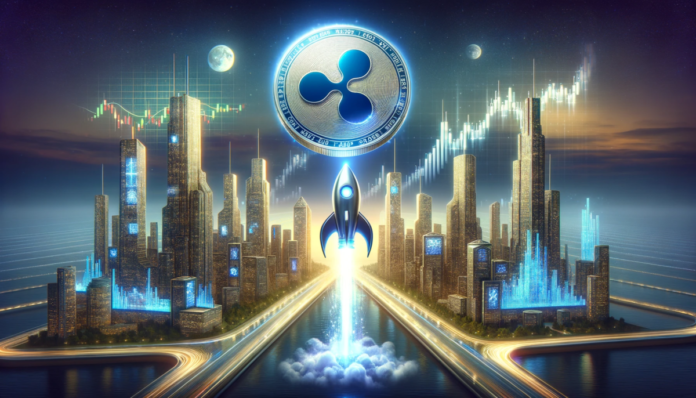- Despite XRP’s price decline to $0.51, with a 20% drop in 2024, traders on the OKX exchange are heavily favoring long (buy) leverage positions.
- This divergence in trader sentiment raises questions about the market’s outlook amid ongoing negative developments surrounding Ripple and legal battles with the SEC.
XRP’s price has dropped to $0.51, marking a 20% decline in 2024 and nearing its lowest daily close since Oct. 18, 2023. Despite this downturn, traders on the OKX exchange are predominantly favoring long (buy) leverage positions.
Interestingly, funding costs for XRP futures have remained steady over the past month, prompting speculation about whether retail traders are mainly anticipating a further decline in price.
XRP’s recent decline in price can be partly attributed to negative developments surrounding Ripple. On February 5, U.S. District Court Judge Sarah Netburn granted a motion from the U.S. Securities and Exchange Commission (SEC), compelling Ripple to disclose financial statements, including contracts governing XRP token “institutional sales.”
The ongoing legal battle with the SEC dates back to December 2020 when the regulator accused Ripple and its executives of offering unregistered securities. The court ruling in July 2023 came in favour of Ripple for reatil sales of XRP. However, the judge stated that the institutional sales for XRP would constitute as a security. The recent court decision suggests that the SEC has bolstered its case, potentially exposing Ripple to further liabilities.
Additionally, investor confidence in Ripple took a hit following a hack targeting the personal accounts of Chris Larsen, the company’s co-founder and executive chairman, on January 31. Analysts noted transactions totaling 213 million XRP, valued at approximately $112.5 million at the time. This incident has raised concerns about the effectiveness of Ripple’s security measures and its impact on the company’s credibility.
XRP Price Action Using Derivatives
In light of recent developments surrounding the XRP token and Ripple, investors may anticipate bearish sentiments among top traders. However, contrary to expectations, the long-to-short ratio suggests otherwise. This ratio consolidates derivatives positions across perpetual and quarterly futures contracts, providing insights into the positions of whales and arbitrage desks.
Notably, top traders at the OKX exchange currently exhibit a 7.2x ratio favoring longs, nearing the highest level observed in the past 30 days—a notable shift from the 1.6x indicator recorded on February 1. Meanwhile, data from the Binance exchange shows a less pronounced skew, with longs favored at a healthy 2x ratio, up from 1.8x on February 1. Essentially, XRP whales and market makers have bolstered their bullish positioning despite the token’s price hovering near the $0.50 mark.
To gauge whether retail traders have taken the opposite stance and leveraged bets on XRP’s price, monitoring perpetual contracts’ funding rate is essential. Also referred to as inverse swaps, these derivative instruments feature an embedded rate typically recalculated every eight hours. A negative rate indicates excessive demand for leverage short positions.
Recent data indicates that XRP funding rates have remained near zero since January 4, signaling a balanced demand for leverage between longs and shorts. Therefore, even as professional traders lean bullish, their positions find a counterparty of similar size in terms of leverage demand from retail traders.
Credit: Source link























 Bitcoin
Bitcoin  Ethereum
Ethereum  XRP
XRP  Tether
Tether  Solana
Solana  USDC
USDC  Dogecoin
Dogecoin  Cardano
Cardano  Lido Staked Ether
Lido Staked Ether  TRON
TRON  Wrapped Bitcoin
Wrapped Bitcoin  Wrapped stETH
Wrapped stETH  Chainlink
Chainlink  Avalanche
Avalanche  Sui
Sui  Stellar
Stellar  Litecoin
Litecoin  Shiba Inu
Shiba Inu  Toncoin
Toncoin  Hedera
Hedera  LEO Token
LEO Token  Hyperliquid
Hyperliquid  USDS
USDS  Polkadot
Polkadot  WETH
WETH  MANTRA
MANTRA  Bitcoin Cash
Bitcoin Cash  Bitget Token
Bitget Token  Ethena USDe
Ethena USDe  Wrapped eETH
Wrapped eETH  Uniswap
Uniswap  Monero
Monero  NEAR Protocol
NEAR Protocol  Pepe
Pepe  WhiteBIT Coin
WhiteBIT Coin  Aave
Aave  Ondo
Ondo  Bittensor
Bittensor  Aptos
Aptos  Internet Computer
Internet Computer  Dai
Dai  Official Trump
Official Trump  Ethereum Classic
Ethereum Classic  Tokenize Xchange
Tokenize Xchange  Mantle
Mantle  OKB
OKB  Gate
Gate  sUSDS
sUSDS  Coinbase Wrapped BTC
Coinbase Wrapped BTC 
